
Cáceres is a city of Spain located in the autonomous community of Extremadura. It is the capital and most populated municipality of the province of Cáceres.
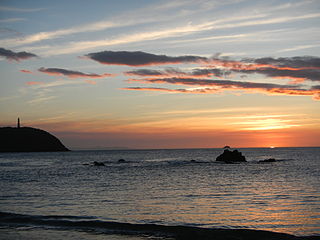
The Nueva Esparta State, is one of the 23 states of Venezuela. It comprises Margarita Island, Coche, and the largely uninhabited Cubagua.

Margarita Island is the largest island in the Venezuelan state of Nueva Esparta, situated off the northeastern coast of the country, in the Caribbean Sea. The capital city of Nueva Esparta, La Asunción, is located on the island.

Barcelona originally founded as Nueva Barcelona del Cerro Santo, New Barcelona or also called La Nueva Barcelona, is a city located in the northeast of Venezuela. Founded in 1557 by the Spanish military conquistador of Catalan origin Joan Orpí. It is the capital of the Anzoátegui State. Barcelona has a population of 954,928 inhabitants, according to INE data, (2011)[1] with Puerto La Cruz, Lecheria and Guanta, making up Greater, Gran Barcelona the largest and most important metropolitan area in the Eastern Region from Venezuela, the city preserves a variety of buildings dating from the viceregal era, Venezuela
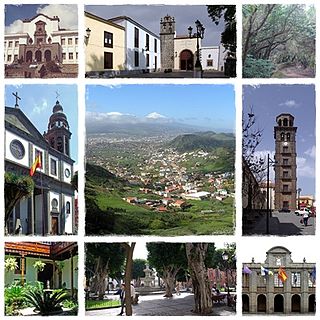
San Cristóbal de La Laguna is a city and municipality in the northern part of the island of Tenerife in the Province of Santa Cruz de Tenerife, on the Canary Islands, Spain. The former capital of the Canary Islands, the city is the third-most populous city of the archipelago and the second-most populous city of the island. La Laguna's historical center was declared a World Heritage Site by UNESCO in 1999. La Laguna is situated alongside the city of Santa Cruz de Tenerife; thus, the two cities and municipalities form a single large urban center. Its economy is business-oriented while agriculture dominates the northeastern portion of the city. The urban area dominates the central and the southern parts.

Carúpano is a city in the eastern Venezuelan state of Sucre. It is located on the Venezuelan Caribbean coast at the opening of two valleys, some 120 km east of the capital of Sucre, Cumaná. This city is the shire town of the Bermúdez Municipality and, according to the 2010 Venezuelan census, the municipality has a population of 173,877 inhabitants. Carúpano is considered the gateway to the Paria Peninsula and its main commercial and financial center.

The Virgin of the Valley is a Roman Catholic title of the Blessed Virgin Mary venerated in Margarita Island, Venezuela and Catamarca, Argentina.
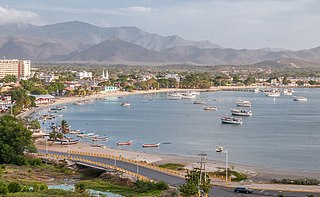
Juan Griego is a city on the northern side of Isla Margarita, and is the most northern port in Venezuela. It has a population of 28,256 inhabitants and is capital of the Marcano municipality of the Nueva Esparta state.
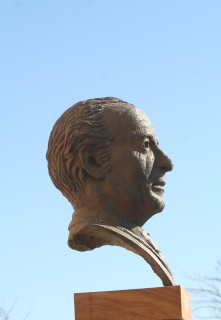
Antonio León Ortega was a Spanish sculptor known for his Andalusian imagery.

The United Church of Christ in the Philippines is a Christian denomination in the Philippines. Established in its present form in Malate, Manila, it resulted from the merger of the Evangelical Church of the Philippines, the Philippine Methodist Church, the Disciples of Christ, the United Evangelical Church and several independent congregations.
Andrés Rodríguez de Villegas (1580–1631) was a Spanish soldier who served as governor and captain-general of the Province of Isla Margarita, Venezuela (1619–1626) and as governor of Spanish Florida (1630–1631).
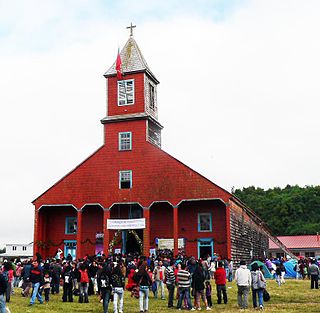
The Iglesia de Caguach is a Catholic church located on the island of Caguach, in the commune of Quinchao on the Chiloé Archipelago, southern Chile.
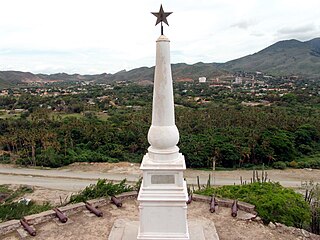
The Battle of Matasiete was a battle in the Venezuelan War of Independence that took place on 31 July 1817 near the city of La Asunción on Isla Margarita in Venezuela. It was fought between pro-independence Republican revolutionaries led by Francisco Esteban Gómez and Spanish Royalist forces under the command of Pablo Morillo. The outcome was a Spanish defeat.
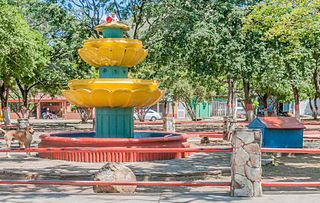
Santa Ana is a town on Isla Margarita, in the state of Nueva Esparta, Venezuela. It is the capital of the Gómez municipality. The town is located in the south of the municipality, in the northeast of Margarita.
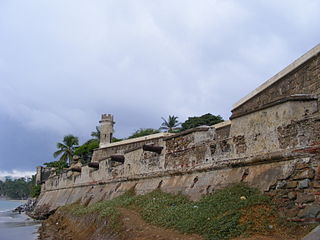
San Carlos de Borromeo Fortress is a colonial fortress in the Bay of Pampatar in the northeast of Isla Margarita, Venezuela. It was completed in 1684 for protection against the constant threat of pirates. The fortress was ransacked several times before Venezuela gained independence from Spain. Today the castle has been restored and serves as a museum.
Juan Muñoz de Gadea was a Spanish soldier who served in Peru, Chile, Mexico and the Philippines. He was appointed Governor of Margarita in 1676.
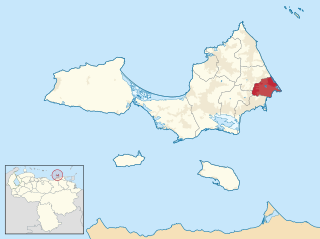
Maneiro is a municipality of Isla Margarita in the state of Nueva Esparta, Venezuela. The capital is Pampatar.
Margarita Fútbol Club is a Venezuelan football team based in Pampatar, Nueva Esparta. Margarita currently play in the Venezuelan Segunda División, the second division in Venezuelan football. The club was founded in 2011, and plays their home games at Estadio Ciudad, a 4,500 seat stadium in Pampatar.
The Iglesia del Espíritu Santo at #161 Calle Acosta in Havana, Cuba, was built in 1635 on the corner of the corner of Calles Cuba and Acosta. The Espíritu Santo contains some notable paintings including a seated, post-crucifixion Christ on the right wall, and catacombs. It is considered one of the oldest temples in Havana and it is said that its main interest lies essentially in the simplicity or simplicity of the beautiful stone construction. Free blacks, already numerous, devoted it to the Holy Spirit in 1638.

The Iglesia del Santo Cristo del Buen Viaje is located in Havana Vieja on Calle Cristo between Calles Lamparilla y Teniente Rey. Built at a time in which transatlantic crossings were risky, it acquired popularity during colonial times as a temple dedicated to travelers and navigators. Travelers and especially sailors would visit before leaving on a journey, and to pay their respects upon arriving back on land. Later during Cuba's republican era, the devotion to Santa Rita was added to the church.




















